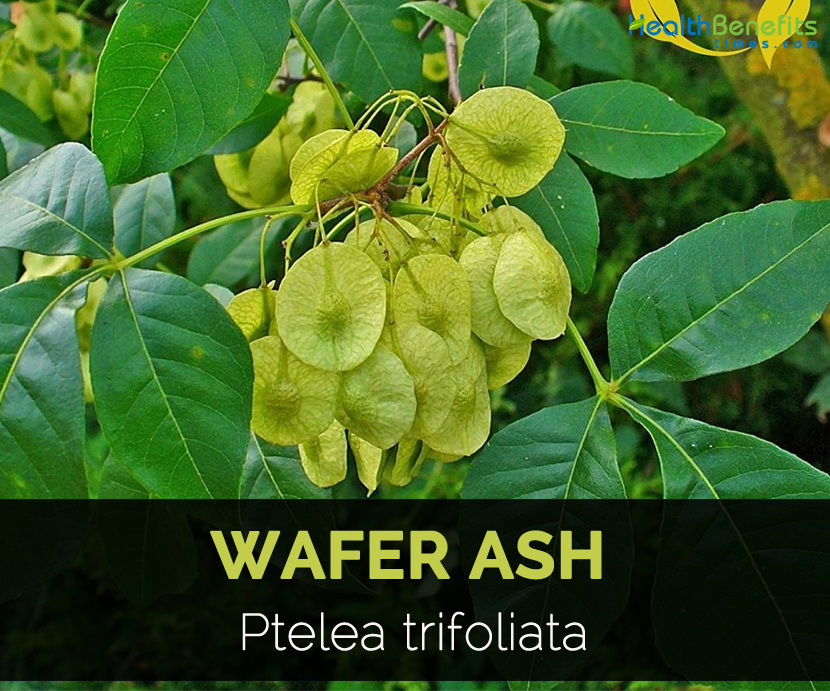| Wafer Ash Quick Facts | |
|---|---|
| Name: | Wafer Ash |
| Scientific Name: | Ptelea trifoliata |
| Colors | Brown |
| Shapes | Round, 0.5 to 1 inch long |
| Name | Wafer Ash |
|---|---|
| Scientific Name | Ptelea trifoliata |
| Common/English Name | Wingseed, Hoptree, Shrubby Trefoil, Swamp Dogwood, Common hoptree, Hop Tree, Pallid hoptree |
| Name in Other Languages | German: Dreiblättriger Lederstrauch, Gewöhnliche Kleeulme; Polish: Parczelina trójlistkowa; Lithuanian: Trilapė ptelija; English: Common hoptree, Hoptree, Shrub trefoil, Wafer-ash, Common hop-tree; Hungarian: Hármaslevelű alásfa |
| Plant Size | 15 feet in height |
| Bark | Gray or red brown, smooth |
| Leaf | Trifoliate, 4-6 inches long |
| Flower | White, cream, gray |
| Fruit shape & size | Round, 0.5 to 1 inch long |
| Fruit color | Brown |
| Medicinal part | Root bark |
Fruit
Flowers mature in summer into drooping clusters of 1 inch wide, light brown and round samaras which are wafer thin. Samara contains 2 to 3 brown seeds surrounded by the thin rounded wing which shows many reticulated membranes. It remains on the tree into winter assisting in identifying this tree.
Uses
It is used for the same purpose as Quinine and may be tolerated by the stomach when other tonics are rejected. Useful for low fever with gastro-intestinal irritation and typhoid conditions. It has a soothing influence upon the mucous membrane in all cases of debility and during intermittent and remittent chills and fever and febrile diseases where a tonic is indicated. Regarded as a remedy for asthma when tinctured with whisky and taken in doses of 1–2 tablespoonfuls every 2–3 hr. It is very useful as a promoter of the appetite. The leaves and young shoots are anthelmintic and the fruit (samara) aromatic, bitter and a good substitute for Hops. 1 teaspoonful of the root bark, cut small, to 1 cupful of boiling water. Drink 1 cupful throughout the day a mouthful at a time. Of the powder, 10–30 grains. Of the tincture, 1–2 drams.
Homoeopathic Clinical
Tincture of root bark—Asthma, Constipation, Dysentery, Dyspepsia, Erysipelas, Gall-stones, Gastralgia, Headache (gastric; bilious), Intermittents, Jaundice, Liver (congestion of), Nightmare, Phosphaturia, Rheumatism, Spleen (affections of), Worms.
Medicinal uses
- Root bark is anthelmintic, antiperiodic, antibacterial, tonic and stomachic.
- Mix it with other medicines in order to add potency.
- It is used for treating intermittent fevers such as heartburn, malaria, pinworms, roundworms and poor digestion.
- Apply it externally to the wounds.
- Use the roots as a tonic for asthmatic breathing, poor appetite and fevers.
- It is used for chronic rheumatism.
Culinary uses
Fruit is used as a substitute for hop for making beer and added to the yeast for rising more quickly for making bread.
References:
https://www.itis.gov/servlet/SingleRpt/SingleRpt?search_topic=TSN&search_value=28992#null
https://pfaf.org/user/Plant.aspx?LatinName=Ptelea+trifoliata
https://botanical.com/botanical/mgmh/a/ashwa078.html
http://hort.ufl.edu/database/documents/pdf/tree_fact_sheets/ptetria.pdf
http://www.naturalmedicinalherbs.net/herbs/p/ptelea-trifoliata=hop-tree.php
https://edis.ifas.ufl.edu/st530
Comments
comments
